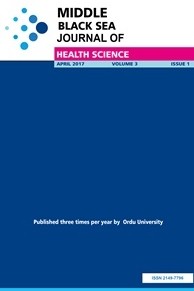Evaluatıon of the Fagerström Nicotine Dependence Test and the Situation of Smoking Patients Wishing to Stop Smoking in the Family Medicine Polyclinic
Evaluatıon of the Fagerström Nicotine Dependence Test and the Situation of Smoking Patients Wishing to Stop Smoking in the Family Medicine Polyclinic
Smoking, Fagerstrom Nicotine Dependence Test, family medicine, dependence,
___
- https://data.tuik.gov.tr/Bulten/Index?p=Turkiye-Saglik-Arastirmasi-2022-49747 Accessed date: 01.08.2023
- https://treaties.un.org/pages/ViewDetails.aspx?src=TREATY&mtdsg_no=IX-4&chapter=9&clang=_en Accessed date: 05.08.2023
- Oğuz, Sıdıka; Çamcı, Gülşah; Kazan, Mahsum. Üniversite öğrencilerinin sigara kullanım sıklığı ve sigaranın neden olduğu hastalıkları bilme durumu. Van Tıp Derg 2018, 25.3: 332-337.
- https://www.who.int/news-room/fact-sheets/detail/noncommunicable-diseases Accessed date: 12.08.2023
- WHO Report on the Global Tobacco Epidemic, 2008: The MPOWER Package. Geneva, World Health Organization, 2008.
- Bahelah R, DiFranza J R., Fouad F M, Ward K D, Eissenberg T, Maziak W. Early symptoms of nicotine dependence among adolescent waterpipe smokers. Tobacco Control. 2016; 25(e2): e127-e134.
- Karlıkaya C. Smoking and profession Solunum. 2004; 6(6): 262-275.
- Argüder E Karalezli A, Hezer H, Kılıç H, Er M, Hasanoğlu H C, Demir P. Factors Affecting the Success of Smoking Cessation Turk Toraks Derg. 2013; 14: 81-7.
- Sağlam l. Clinical Evaluation of Nicotine Dependence. Current Chest Diseases Series. 2017; 4 (1): 78-89.
- Esen A D, Arıca S. The Evaluation of Nicotine Dependence Levels and Sociodemographic Characteristics Among Applicants Admitted for Smoking Cessation. Ankara Med J 2018;(3):328‐36.
- Tanrıöver Ö. Mental Health and Substance Abuse Usage Screening and Consulting. Klinik Tıp Aile Hekimliği Derg 2017; 9(2): Sayfa 51-54
- Heatherton TF, Kozlowski LT, Frecker RC, Fagerström KO. The Fagerström Test for Nicotine Dependence: a revision of the Fagerström Tolerance Questionnaire. Br J Addict. 1991; 86:1119‐27.
- Bozkurt N, Bozkurt Aİ, Evaluation of the Fagerström Test for Nicotine Dependence (FBNT) in determining nicotine addiction and Creation of a new test for nicotine addiction. Pamukkale Medical Journal. 2016;9(1):45‐51
- Uysal MA, Kadakal F, Karşidağ C, Bayram NG, Uysal O, Yilmaz V. Fagerström test for nicotine dependence: reliability in a Turkish sample and factor analysis. Tuberk Toraks 2004; 52:115‐21.
- Örsel O, Örsel S, Alpar S, Uçar N, Fırat Güven S, Şipit T, Kurt B . The Effect of Nicotine Dependence Levels on Treatment Outcomes in Smoking Cessation. Respiratory Diseases 2005; 16: 112-118
- Fagerstrom KO, Kunze M, Schoberberger R, et al. Nicotine dependence versus smoking prevalence: Comparisons among countries and categories of smokers 1996; 5:1-3.
- Bostan Pazarlı P, Elbek O, Kılınç O, Akçay Ş, Kıran S. Attitudes and Behaviors of Chest Disease Physicians, Members of Turkish Thoracic Society, in the Field of Tobacco Control. Smoking and Health National Committee 5th Annual Congress, 8-11 May 2011 Kocaeli.
- Tezcan S, Yardım N. In Various Health Institutions in TurkeyDoctor, Nurse and Faculty of Medicine Students' Smoking Dimension. Tüberküloz ve Toraks Derg 2003; 51(4): 390-397.
- Sezer RE, Öztürk ŞZ, Bilgin N, Açık Y. Behaviors and Attitudes of Physicians and Dentists Working in Elazig about Smoking. Doğa- Tr. J. Of Medical Sciences 1990; 14: 381-90.
- Gorın, Sherri Sheinfeld; Heck, Julia E. Meta-analysis of the efficacy of tobacco counseling by health care providers. Cancer Epidemiology Biomarkers & Prevention 2004, 13.12: 2012-2022.
- Ünalacak M, Altın R, Kart L, et al. Smoking prevalence, behaviour and nicotine addiction among coal workers in Zonguldak. Turkey. J Occup Health 2004; 46:289-295.
- Aksakal A, Khorshid L. Investigation of smoking and nicotine addictions of individuals working in Adana TEKEL factory. Bağımlılık Derg 2006; 7:57-64.
- Terzi, Ö., Kumcağız, H., Terzi, M., & Dündar, C. Cigarette Smoking and Determination of Nicotine Dependence Levels in University Students. Addicta: The Turkish Journal on Addictions 2019;6.4: 168-181.
- Akan, H., Hayran, O., Özcan, M., & Acar, U. Smoking prevalence among university students: a cross-sectional study. Turkish Journal of Family Practice 2010, 14.2: 71-76.
- Oğuz S, Çamcı G, Kazan M. Üniversite öğrencilerinin sigara kullanım sıklığı ve sigaranın neden olduğu hastalıkları bilme durumu. Van Tıp Derg 2018, 25.3: 332-337.
- Erol S, Erdoğan S. Application of a stage based motivational interviewing approach to adolescent smoking cessation: The Transtheoretical Model-based study. Patient education and counseling 2008, 72.1: 42-48.
- Benegal V, Sugunan AP, Jeemon P, et al. Tobacco use and nicotine dependency in a cross‐ sectional representative sample of 18,018 individuals in Andaman and Nicobar Islands, India. BMC Public Health. 2012; 12:515.
- Yayın Aralığı: Yılda 4 Sayı
- Başlangıç: 2015
- Yayıncı: Ordu Üniversitesi
Analysis of YouTube Videos on Initiating Postpartum Sexual Life
Reyhan ERKAYA, Yeliz KAŞKO ARICI
Hastaneye Prenatal Bakım için Başvuran Gebelerde Risk Faktörlerinin ve Riskli Gebeliklerin Analizi
Hasan ULUBAŞOĞLU, Saime ŞAHİNÖZ, Turgut ŞAHİNÖZ, Pınar ULUBAŞOĞLU
Bestegül ÇORUH AKYOL, Mervegül KAYA, Muhammet ÖZDEMİR, Ömer Ufkun YİLDİRİM, Cihan ÖZDEMİR, Özgür ENGİNYURT, Soner ÇANKAYA
Gürkan ÇIKIM, Solmaz SUSAM, Mustafa GÖKSU, Fatih ÜÇKARDEŞ, Muhittin ÖNDERCİ
Evaluation of Department Preferences of Faculty of Medicine Assistants: The Case of Ordu
Bestegül ÇORUH AKYOL, Yeliz KAŞKO ARICI
Surveillance of Infection Control in Dental Settings During Covid-19 Pandemic
Mehmed Taha ALPAYDIN, Damla TORUL, Mehmet Melih ÖMEZLİ
Ebru CANAKCİ, Nilay TAŞ, Aysenur KİRDEMİR, Ismail ELMALİ, Melih ÜRKMEZ
The Impact of The COVID-19 Pandemic on Smoking Cessation
Emine Serap YILMAZ, Selen KARAOĞLANOĞLU, Nurhan KÖKSAL
A New Material For Detecting Submerged Implants: An Animal Experiment
